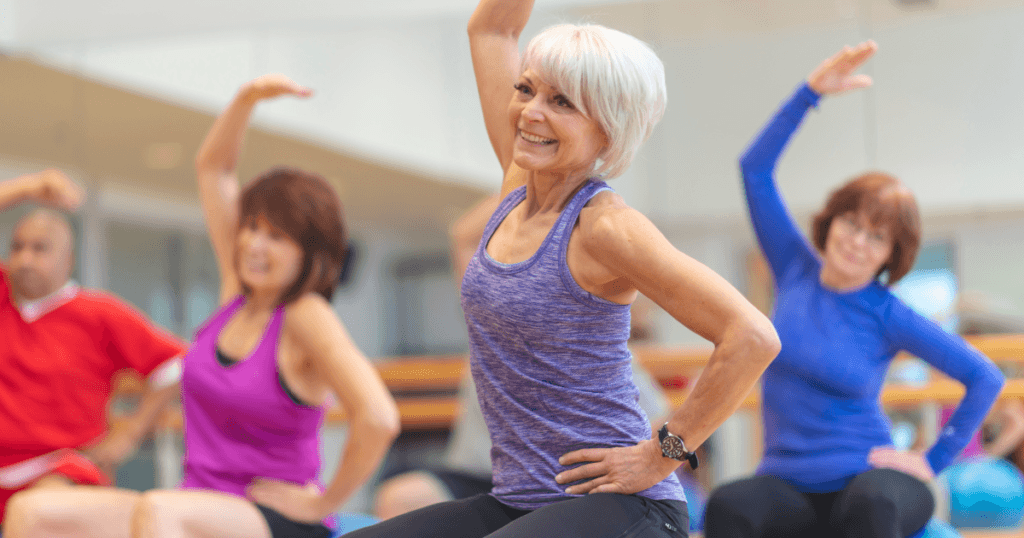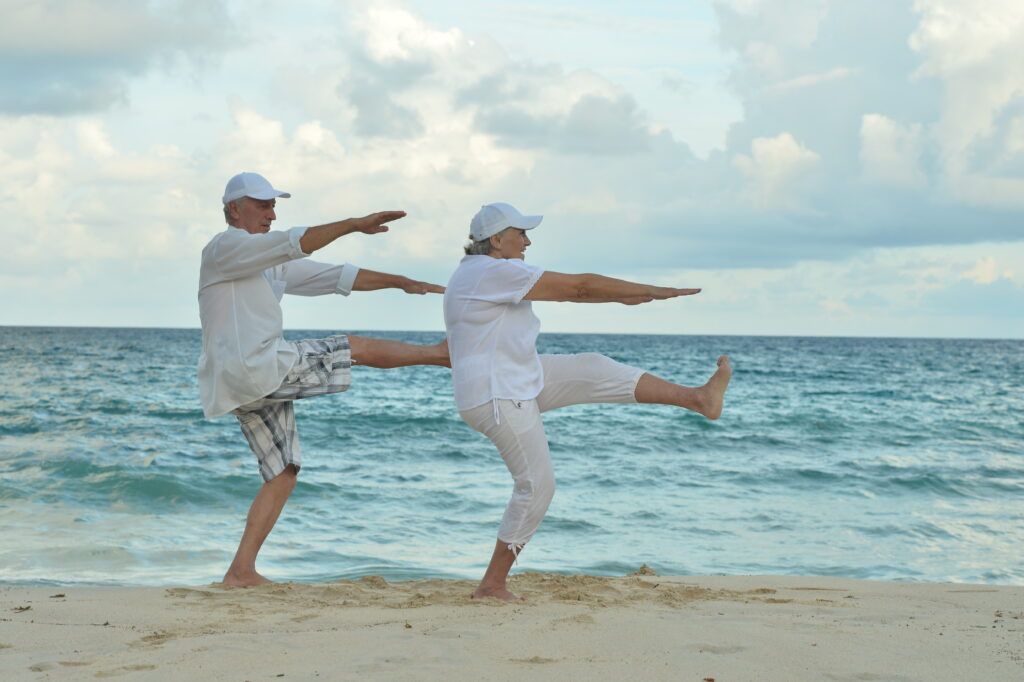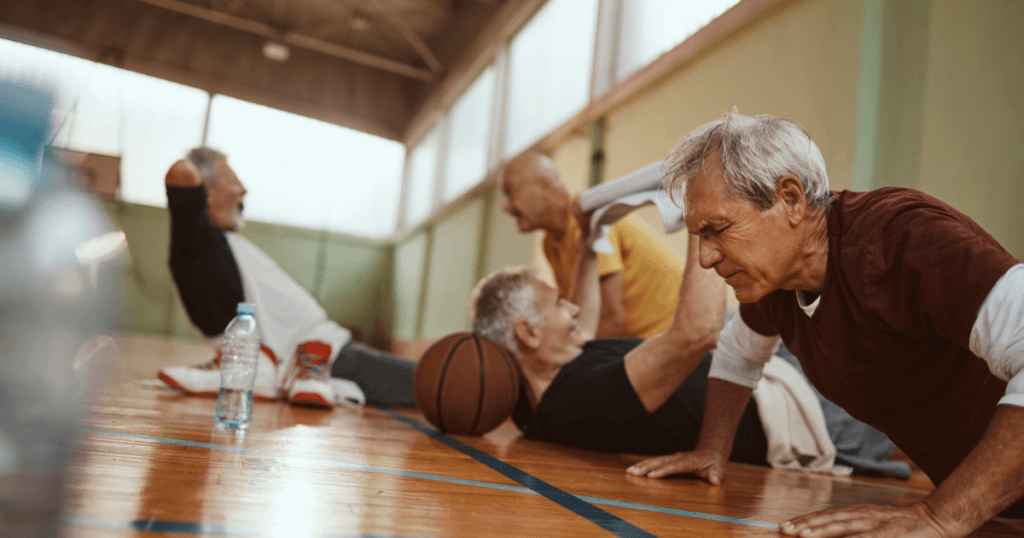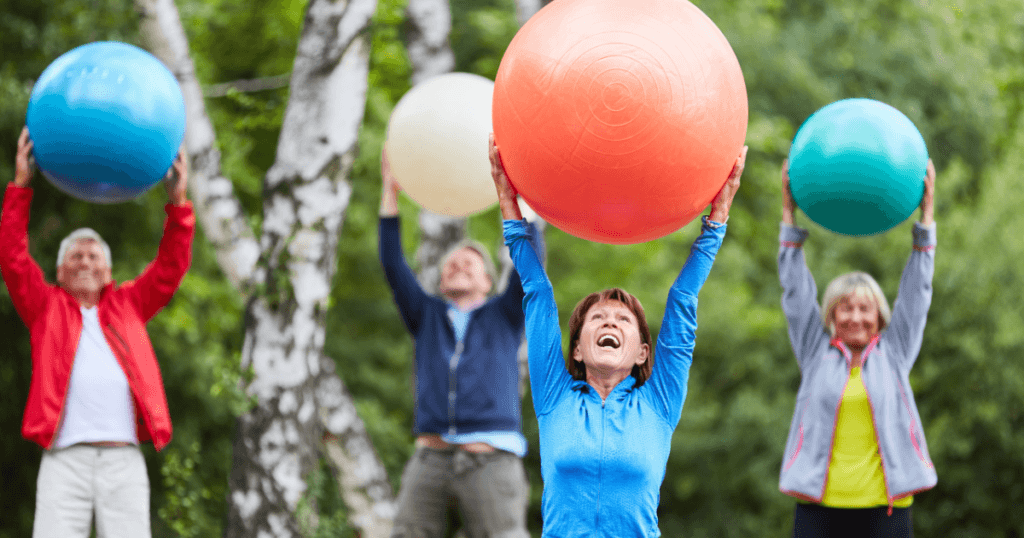Engaging in physical activity is crucial at any age, but finding Safe Exercises for Seniors is especially important.
As we age, our bodies may not be able to handle the same stress and strain they once did, so it’s key to select exercises that minimize the risk of injury while promoting health and mobility.
3 Benefits Of Safe Exercises for Seniors
Safe exercises for seniors are crucial for maintaining health and wellness as they age. Here are three benefits of engaging in safe exercise routines for older adults:
- Improved Physical Health: Safe exercises help seniors maintain their muscle strength, flexibility, and balance, which are essential for everyday activities. Regular physical activity can reduce the risk of chronic diseases such as heart disease, diabetes, and osteoporosis. It also helps manage weight, reduces the impact of arthritis, and can improve the overall function of the cardiovascular system.
- Enhanced Mental Well-being: Exercise is good for the body and the mind. Physical activity can help reduce symptoms of depression and anxiety, improve mood, and boost self-esteem. Additionally, exercises that involve coordination and strategy (like dancing or tai chi) can help keep the brain active and potentially slow cognitive decline.
- Increased Independence: By maintaining physical health through safe exercise, seniors can preserve their independence for longer. Stronger muscles and better balance can reduce the risk of falls, which are a common cause of injury in older adults. Being able to perform daily tasks without assistance also contributes to a greater sense of autonomy and quality of life.
Incorporating safe exercises into a senior’s routine, ideally with a mix of cardiovascular, strength, flexibility, and balance training, and with the approval and guidance of a healthcare professional, can help ensure that they reap these benefits effectively and sustainably.
Safe Exercises for Seniors-Key Takeaways
- Selecting Safe Exercises for Seniors helps maintain muscle strength and improve balance.
- A combination of endurance activities, strength training, and stretching is recommended.
- Consistency in exercise routines contributes to ongoing health and mobility.
Stretching exercises improve flexibility and aid in injury prevention, while balance routines help prevent falls, a common concern for aging individuals.

The Importance of Staying Active
As we age, staying active plays a crucial role in maintaining and improving our health and independence. Let’s explore the why and how of staying physically active for senior citizens.
Health Benefits for Seniors
Physical Activity and Heart Health: Regular exercise, such as brisk walking or swimming, helps keep my heart strong, which is vital for cardiovascular health.
Studies show that adults who are physically active are at a lower risk of heart disease than those who are inactive.
Managing Blood Pressure: Being active also helps me manage my blood pressure, reducing my risk of hypertension. This contributes to overall heart health and prevents additional complications.
Muscle and Bone Strength: Regular physical activity preserves my muscle mass and bone density, which diminish as I age. This strength is key to maintaining my balance and preventing falls, a common concern for us seniors.
Independence: By staying physically active, I am able to perform daily tasks more easily, which maintains my independence. Whether it’s carrying groceries or climbing stairs, being active keeps me capable.
Understanding Your Fitness Goals
Setting Realistic Goals: My fitness goals are personal and based on my current health and lifestyle.
They range from improving flexibility to enhancing stamina.
Adaptable Exercise Plans: I value listening to my body and adjusting my exercise routine accordingly.
Engaging in low-impact activities like yoga or Pilates suits me well and keeps me physically active without putting undue stress on my body.
Professional Guidance: Consulting with a healthcare provider or a fitness professional helps me create a safer and more effective exercise plan tailored to my health status and goals.

Consulting Healthcare Providers
Before incorporating any new exercise routine, it’s crucial for me to consult with a healthcare provider, especially if I have pre-existing conditions or concerns. It ensures that I get personalized advice aligned with my health status.
When to Talk to Your Doctor
I always talk to my doctor before starting any new exercise program, especially since I know that certain exercises may not be suitable for everyone.
A doctor can provide me with a comprehensive overview of:
- My current health status: Understanding any existing health issues is vital. Based on my health history, I need to know if certain exercises could potentially harm me.
- Tailored exercise recommendations: My doctor can suggest safe and beneficial exercises.
- The role of supervision: Sometimes, my doctor might advocate supervised exercises, especially if I’m at risk of falling or have a chronic condition. In such cases, I might need a physical therapist by my side.
- Adaptations for my abilities: If I have mobility limitations, my healthcare provider can guide me on adapting exercises to my capabilities, ensuring I stay active without overdoing it.

Safe and Effective Exercise Routines
As a senior aiming to stay active and healthy, I know that striking the right balance in my exercise routine is crucial. It’s not just about being safe; it’s about ensuring that each activity packs the most punch in terms of health benefits without overdoing it.
Starting with low-impact activities
When kickstarting an exercise plan, I always begin with low-impact activities.
This means that exercises like walking, swimming, or gentle yoga are my go-to choices.
They increase my heart rate without putting too much stress on my joints. Plus, they are fun!
Building Muscle Strength and Flexibility
I incorporate strength training into my routine a couple of times a week to maintain muscle mass.
I find that exercises such as wall pushups, resistance band workouts, and lightweight lifting are effective.
For flexibility, nothing beats a good stretch session or some Pilates moves.
Balance and Stability Workouts
To keep my balance sharp, I include balance exercises in my routine.
Tai chi and balance exercises for seniors, like heel raises and one-foot stands, are excellent for improving stability.
I make sure to have support nearby, like a chair, when I’m working on these.
Cardiovascular Endurance Exercises
Lastly, for my heart health, I weave in some cardiovascular exercises.
This can range from brisk walking to water aerobics or even a light cycling session.
I always listen to my body to prevent overexertion, aiming for a moderate level of breathlessness that I can sustain.

Injury Prevention and Safety Tips
When I think about staying active in later years, the priority is always to prevent injuries while maintaining as many of the benefits of exercise as possible. So, I focus on making smart modifications to workouts and using helpful tools to keep things safe.
Modifying Exercises to Reduce Risk
I’ve learned that modifying exercises greatly reduces the risk of falls and other injuries.
For example, if a traditional squat is too challenging or poses a risk, I switch to a sit-to-stand exercise using a sturdy chair.
This helps to maintain muscle mass while keeping the exercise accessible and safe for my joints.
I often use light hand weights or even just a couple of water bottles to avoid overstraining when doing arm curls.
Let’s talk about balance exercises. A back leg raise can be done by holding onto the kitchen counter for support, ensuring stability while still benefiting the leg muscles.
It’s key to keep the heart rate up safely, especially if I’m managing conditions like arthritis.
Using Assistive Devices and Props
Incorporating assistive devices and props into my routine helps me maintain my fitness without compromising on safety.
Resistance bands are a favorite of mine because they add some resistance to my workouts without the need for heavy weights. They’re especially handy for exercising when I’m sitting down.
Another tip I’ve picked up is always to have a sturdy chair nearby, not just for exercises like the sit-to-stand but also to have something to grab onto in case I feel unstable.
Plus, I keep activities like squatting to a half-squat or using a wall for support to prevent any mishaps.
I also make sure the spaces where I exercise are clutter-free to avoid trips and falls, and every piece of equipment I use is within easy reach to keep things both safe and accessible.

Staying Motivated and Consistent
I believe one of the most challenging aspects of sticking to an exercise routine is maintaining high motivation and consistency, especially as we get older.
It’s key for seniors like me to set realistic and attainable goals and then acknowledge the milestones reached.
Setting Achievable Exercise Goals
The exercise plans I create are straightforward and tailored to my current level of fitness and health.
By choosing objectives I can actually reach, the process becomes less daunting.
Implementing easy, beneficial exercises designed for seniors helps me avoid injury and keeps me on track. Here’s how I like to approach it:
- Short-term goals: I might aim to walk 15 minutes daily.
- Long-term goals: Gradually, I work towards completing a 30-minute walk.
Remember, the focus is on being healthy and staying active, not necessarily on competing with others or my younger self.
Tracking Progress and Celebrating Milestones
I’ve learned that keeping an exercise journal gives me a clear view of my progress and fuels my motivation. Here are some tips I’ve picked up along the way:
- Regular Entries: Each day, after my walk or workout, I jot down what I did and for how long.
- Milestone Recognition: Every month, I look back to see how far I’ve come. If I’ve improved my endurance or found myself sleeping better post-exercise, I give myself a pat on the back.
By staying consistent with these practices, my fitness goals no longer feel like chores but rather a part of my lifestyle that I genuinely enjoy.

Conclusion
After exploring various exercises, I’ve noticed that incorporating strength, cardiovascular, and flexibility workouts into my routine significantly boosts my physical health.
Strength training helps maintain muscle mass and supports joint health when done safely.
I’m keen on exercises that I can perform at home or in a group, like Tai Chi or going for a gentle walk, to keep my heart healthy without undue stress.
Keeping active with these types of exercises can enhance balance and stability, which is super important for preventing falls.
I’ve learned that core exercises are key for this. Plus, I don’t need any fancy equipment.
I definitely remember to include stretches, too. A daily routine to improve my flexibility has been amazing for my posture and eases any day-to-day stiffness.
Lastly, I remember to make workouts enjoyable. The more I enjoy them, the more likely I am to stick with them. And that’s the secret sauce to staying fit – consistency. Let’s keep moving and have fun with it!

Frequently Asked Questions
In this section, I’ll address some of seniors’ most common questions about staying active and healthy.
Which activities are recommended for individuals over 60 to maintain their health?
For those in their 60s, a mix of aerobic, muscle-strengthening, and flexibility exercises is often recommended.
Walking, swimming, and yoga are popular choices because they are low-impact and can be modified to suit individual comfort levels.
How often should a person over 70 engage in physical activity?
Health professionals suggest that individuals over 70 aim for at least 150 minutes of moderate-intensity aerobic activity every week and incorporate muscle-strengthening activities two or more days a week.
Are there any specific exercise guidelines for people above 80 years old?
Yes, even for people over 80, regular physical activity is crucial. The focus should largely be on balance exercises to prevent falls. In addition, older individuals should do gentle strength training and aerobic activities. They should also adapt the intensity and duration based on their fitness levels and health conditions.
Up Next
- Why Seniors Should Exercise 10 Benefits of Having an Active Lifestyle
- What Type Of Bicycle Is Best For Seniors
- Are Bidets Good For Seniors
